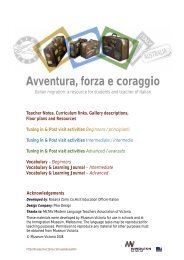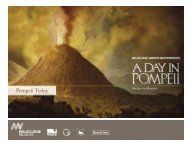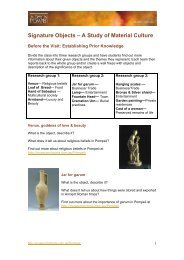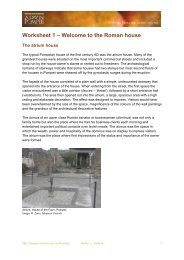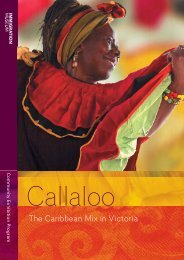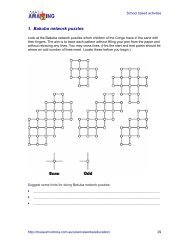Kurds in Australia - Museum Victoria
Kurds in Australia - Museum Victoria
Kurds in Australia - Museum Victoria
You also want an ePaper? Increase the reach of your titles
YUMPU automatically turns print PDFs into web optimized ePapers that Google loves.
Community Exhibition Program<br />
Survival of a culture<br />
<strong>Kurds</strong> <strong>in</strong> <strong>Australia</strong>
Murat and Ilknur at a multicultural<br />
performance <strong>in</strong> Melbourne, 1993.<br />
Source: KAV Archives<br />
Kurdish people <strong>in</strong> <strong>Australia</strong> trace their orig<strong>in</strong>s back to an ancient culture<br />
that flourished more than 10,000 years ago <strong>in</strong> Kurdistan, a wide arc<br />
of mounta<strong>in</strong>s and plateaus <strong>in</strong> the northern regions of the Middle East.<br />
Many waves of <strong>in</strong>vasion, occupation and displacement have built upon<br />
the orig<strong>in</strong>al culture, but echoes of it can still be found <strong>in</strong> the traditions<br />
and practices of Kurdish people today.<br />
At the conclusion of World War I, the Allied powers and Turkey divided<br />
Kurdistan among Iraq, Iran, Syria and Turkey. We <strong>Kurds</strong> have never<br />
accepted the partition of our traditional land, and ever s<strong>in</strong>ce there has<br />
been much conflict and violence.<br />
<strong>Australia</strong>’s first Kurdish migrants arrived <strong>in</strong> the 1960s and were mostly<br />
from Turkey. In the 1980s and 1990s, Kurdish refugees arrived to escape<br />
the Iran–Iraq War and the Gulf War. In recent years, Kurdish migrants<br />
have also come as refugees from countries such as Armenia and<br />
Georgia, to which they had <strong>in</strong>itially fled. The largest communities are<br />
<strong>in</strong> Sydney and Melbourne, and <strong>in</strong> 2006 around 2000 <strong>Victoria</strong>ns claimed<br />
Kurdish ancestry. However, those of us with<strong>in</strong> the Kurdish community<br />
believe this number is much higher.<br />
As Kurd-<strong>Australia</strong>ns we are free to celebrate our ancient culture <strong>in</strong> a<br />
new home, and we enjoy the peace and harmony that we have found<br />
<strong>in</strong> <strong>Australia</strong>.<br />
6<br />
4<br />
‹1› A community elder demonstrates<br />
techniques for mak<strong>in</strong>g dow, a<br />
traditional yoghurt dr<strong>in</strong>k, 1993.<br />
Source: KAV Archives<br />
‹2› The cultural tent of the Kurdistan<br />
Women’s League of <strong>Australia</strong> with a<br />
display of artefacts, <strong>in</strong>clud<strong>in</strong>g weav<strong>in</strong>g,<br />
2009.<br />
Source: KAV Archives<br />
Photograph: Mehmet Akgun<br />
‹3› Fidan Sengul demonstrates<br />
breadmak<strong>in</strong>g techniques at a local<br />
community event, 1993.<br />
Source: KAV Archives<br />
K<strong>in</strong>e em: We, the <strong>Kurds</strong><br />
1<br />
5<br />
2<br />
3<br />
‹4› The Kurdish Association of <strong>Victoria</strong><br />
dance group performs at a Kurdish<br />
wedd<strong>in</strong>g <strong>in</strong> Melbourne,1990.<br />
Source: KAV Archives<br />
‹5› Young <strong>Kurds</strong> proudly express<br />
their cultural heritage through dance,<br />
Melbourne, 2009.<br />
Source: KAV Archives<br />
Photograph: Mehmet Akgun<br />
‹6› A children’s dance team at a<br />
community event, Reservoir, 2009.<br />
Source: KAV Archives<br />
Photograph: Dilek Giyik
The ma<strong>in</strong> pattern on this carpet<br />
represents the ‘tree of life’, which<br />
is framed by a comb symbolis<strong>in</strong>g<br />
protection of marriage and birth.<br />
The star represents protection<br />
aga<strong>in</strong>st wolves.<br />
Photograph: David Loram<br />
One of the most powerful ways that Kurdish culture is ma<strong>in</strong>ta<strong>in</strong>ed is<br />
through the language of symbols embodied <strong>in</strong> tattoos and handcrafts.<br />
Some of these symbols reach back to the very beg<strong>in</strong>n<strong>in</strong>g of our<br />
history. The symbols are our ancient written language, and every<br />
design carries mean<strong>in</strong>g.<br />
The symbols have changed very little over time. Some are tribal and<br />
have been handed down from community elders. Many are <strong>in</strong>tended to<br />
ward off bad luck, or else to attract happ<strong>in</strong>ess and prosperity. Many of<br />
them are taken from nature and are stylised versions of animals, trees<br />
and stars. Symbols have also historically held special significance <strong>in</strong><br />
Kurdish religions.<br />
Most of the designs are simple forms, easy to reproduce, but they<br />
carry complex mean<strong>in</strong>gs that have survived for thousands of years.<br />
They are the oldest source of our history, a history that otherwise<br />
would have been lost.<br />
3<br />
Symbols of survival<br />
2<br />
‹1› Fram<strong>in</strong>g this carpet is a l<strong>in</strong>e of<br />
birds represent<strong>in</strong>g love and happ<strong>in</strong>ess.<br />
The ‘evil eye’ on the upper right corner<br />
wards off misfortune.<br />
‹2› The diamond shape featured <strong>in</strong><br />
this carpet represents courage and<br />
strength.<br />
‹3› Hand-knitted socks ma<strong>in</strong>ly use<br />
the symbols of protection from snake<br />
bites and represent fertility.<br />
Photographs: David Loram<br />
1
Deq, the art of tattoos<br />
1<br />
2<br />
3 4 5<br />
The art of adorn<strong>in</strong>g the face and body with tattoos has a very long<br />
history <strong>in</strong> Kurdish culture. Tattoo<strong>in</strong>g carries symbolism from old belief<br />
systems, such as paganism, shamanism and Zoroastrianism, overlaid<br />
with many other <strong>in</strong>fluences.<br />
Traditionally, tattoos are made by mix<strong>in</strong>g soot with the breast milk of a<br />
woman who has given birth to a girl and the poisonous liquid from the<br />
gall bladder of an animal. The design is drawn on the sk<strong>in</strong> us<strong>in</strong>g a th<strong>in</strong><br />
twig and is, with the help of a sew<strong>in</strong>g needle, penetrated under the sk<strong>in</strong>.<br />
Tattoos last a lifetime.<br />
The most common tattoo symbols are those that protect aga<strong>in</strong>st evil<br />
forces; ma<strong>in</strong>ta<strong>in</strong> good health or cure illnesses; show tribal affiliations;<br />
and enhance beauty, sexuality and fertility. Tattoos are placed on the<br />
most significant parts of the body, such as near the mouth and nostrils,<br />
between the eyebrows and close to the breasts and genitals. Today,<br />
a decreas<strong>in</strong>g number of <strong>Kurds</strong> are choos<strong>in</strong>g permanent tattoos. More<br />
commonly, temporary mark<strong>in</strong>gs are drawn on the face for special<br />
occasions and as a gesture of respect for this traditional cultural practice.<br />
<strong>Kurds</strong> <strong>in</strong> <strong>Australia</strong> use ancient symbols for their tattoos, but they have<br />
also developed new designs. For young people, the art of tattoo<strong>in</strong>g is an<br />
expression of their cultural identity and a mark of respect for their elders.<br />
‹1› The ‘tree of life’, which <strong>in</strong> ancient<br />
times is said to have reached the<br />
skies, is one of the most common<br />
symbols used <strong>in</strong> Kurdish tattoos.<br />
It represents immortality. This tattoo<br />
starts between the breast and climbs<br />
upwards towards the ch<strong>in</strong> like a v<strong>in</strong>e.<br />
Photograph: Ilhan Bakir<br />
‹2› The tattoo on this elder’s forehead<br />
represents the sun to Yezidi followers,<br />
to which they pray every morn<strong>in</strong>g.<br />
The stars and crosses on the ch<strong>in</strong><br />
are remnants of the times when<br />
they worshipped the skies. The circle<br />
symbolises the womb.<br />
Photograph: Ilhan Bakir<br />
‹3› A male Kurd wears a tattoo of<br />
Faravahar. The symbol depicts a figure<br />
surrounded by the light of glory that<br />
represents the human soul.<br />
Photograph: Cigdem Guler<br />
‹4› A Kurdish elder bears traditional<br />
tattoos on his hand. The two semicircles<br />
over the wrist symbolise<br />
testicles and men’s reproductive<br />
powers. The comb at the base of the<br />
circles represents the strong muscles<br />
required to work the land successfully.<br />
The cross protects aga<strong>in</strong>st evil.<br />
Photograph: Ilhan Bakir<br />
‹5› This ‘tree of life’ tattoo features<br />
a row of circles bisected by a<br />
vertical l<strong>in</strong>e, symbolis<strong>in</strong>g mat<strong>in</strong>g and<br />
reproduction.<br />
Photograph: Ilhan Bakir, 2004<br />
‹ MAIN IMAGE AND RIGHT ›<br />
Kurdish girls often decorate their<br />
cheeks with temporary tattoos for<br />
community events, 2004.<br />
Source: KAV Archives<br />
Photograph: Anna Bagdas<br />
‹ LEFT › Tattoos cont<strong>in</strong>ue to be<br />
an acceptable form of cultural<br />
expression <strong>in</strong> the community.<br />
Symbols like the zulfiqar, a<br />
sword, are significant for <strong>Kurds</strong><br />
of the Alevi faith.<br />
Photograph: Perihan Gel, Dilek Giyik, 2009
Twana Nwri wears a Kurdish suit<br />
hand woven from goat’s wool<br />
made <strong>in</strong> the mounta<strong>in</strong> area of<br />
Hawraman, 1999.<br />
Source: Melbourne Kurdish Foundation<br />
Traditional handcrafts are an important part of the lives of <strong>Kurds</strong> <strong>in</strong><br />
<strong>Australia</strong> because they keep us connected with our past.<br />
For the <strong>Victoria</strong>n Kurdish community, the most important textile is the<br />
carpet, or cil. Carpets are still made <strong>in</strong> the traditional manner, <strong>in</strong> which<br />
wool is carded, spun, dyed and woven, all by hand. A Kurdish cil is a<br />
flat-woven rug, also known as a kilim. The technique is also used to<br />
produce smaller household items such as bags, cushions and runners.<br />
Geometric symbols are either woven <strong>in</strong>to the rug dur<strong>in</strong>g its production<br />
or embroidered on later. Many of the designs are the same as those<br />
used <strong>in</strong> traditional tattoos.<br />
Costumes also carry many symbolic designs. The women’s robes <strong>in</strong><br />
particular are beautifully embroidered with motifs <strong>in</strong> rich materials,<br />
set off by elaborate headwear and gold jewellery. Hand-knitted socks<br />
<strong>in</strong> brilliant colours also carry important symbolic patterns. Men wear<br />
these colourful socks and patterned vests, while the rest of their<br />
cloth<strong>in</strong>g is pla<strong>in</strong>.<br />
Most people <strong>in</strong> <strong>Victoria</strong>’s Kurdish community wear traditional cloth<strong>in</strong>g<br />
for special occasions such as, cultural events or family celebrations.<br />
Older people cont<strong>in</strong>ue to wear them as everyday clothes.<br />
4<br />
3<br />
2<br />
Woven <strong>in</strong> time<br />
‹1› Community volunteers<br />
demonstrate Kurdish carpet-mak<strong>in</strong>g<br />
techniques at a community festival,<br />
1993.<br />
Source: KAV Archives<br />
‹2› Carpet mak<strong>in</strong>g tools (from left to<br />
right); Teshi, two different sp<strong>in</strong>dles<br />
used for sp<strong>in</strong>n<strong>in</strong>g wool; chifle, an<br />
implement for comb<strong>in</strong>g the weave;<br />
and sarne farsh, used to compress<br />
each l<strong>in</strong>e of weave.<br />
Photograph: David Loram<br />
‹3› A community elder demonstrates<br />
wool-sp<strong>in</strong>n<strong>in</strong>g at the Kurdistan<br />
Women’s League exhibition<br />
celebrat<strong>in</strong>g International Women’s<br />
Day, 2002.<br />
Source: KAV Archives<br />
Photograph: Anna Bagdas<br />
‹4› A community elder mak<strong>in</strong>g a flat<br />
weave cil dur<strong>in</strong>g a carpet-mak<strong>in</strong>g<br />
class, 1996.<br />
Source: KAV Archives<br />
1
‹1› A mishki, a male headscarf.<br />
‹2› A claw, hand-knitted men’s cap.<br />
Photographs: David Loram<br />
‹3› Community members <strong>in</strong> traditional<br />
dress at a function at All Nations Park,<br />
Melbourne, 2007.<br />
Source: Melbourne Kurdish Foundation<br />
‹4› Dilek and Nebih modell<strong>in</strong>g<br />
traditional dress at a Kurdish<br />
community fashion parade for<br />
International Women’s Day, 2004.<br />
Source: KAV Archives<br />
Photograph: Anna Bagdas<br />
‹5› Women’s dress of the Riha region.<br />
‹6› Women’s Mahabad-style dress.<br />
‹7› Women’s Sulaimany or Babanistyle<br />
dress.<br />
Photographs: David Loram<br />
1<br />
3<br />
2<br />
4<br />
5 6 7
Music and dance<br />
Kurdish music and folk dance have played a vital role <strong>in</strong> the survival of<br />
Kurdish culture and its preservation with<strong>in</strong> the Kurdish community <strong>in</strong><br />
<strong>Australia</strong>.<br />
There are three types of Kurdish classical performers: storytellers<br />
(çîrokbêj), m<strong>in</strong>strels (stranbêj) and bards (dengbêj). Many songs are<br />
epic ballads, recount<strong>in</strong>g the tales of Kurdish heroes or the sorrow of<br />
separation and unfulfilled love. Music is also closely tied to religious<br />
ceremonies and the transitions of life.<br />
Traditional <strong>in</strong>struments found <strong>in</strong> all parts of Kurdistan are the tembûr,<br />
bilûr, zirne, dahol and daf, and these are also used by Kurdish musicians<br />
<strong>in</strong> <strong>Australia</strong>. The last decade has seen Kurdish music greatly <strong>in</strong>fluenced<br />
by Western music, creat<strong>in</strong>g Kurdish pop and Kurdish hip-hop.<br />
In contrast to the evolution and diversification of Kurdish music, Kurdish<br />
folk dance <strong>in</strong> <strong>Australia</strong> has rema<strong>in</strong>ed true to its roots. It is a form of<br />
l<strong>in</strong>e danc<strong>in</strong>g, with one or two figure dancers often added to the centre<br />
of the danc<strong>in</strong>g circle. The dances tell of the customs, traditions and<br />
everyday life of Kurdish people, enact<strong>in</strong>g work, the marriage ceremony<br />
and notable battles and wars. The dances are always performed to live<br />
music played on traditional <strong>in</strong>struments.<br />
‹ ABOVE › The bilur and the mey are the<br />
ma<strong>in</strong> woodw<strong>in</strong>d <strong>in</strong>struments used <strong>in</strong><br />
Kurdish music of all regions.<br />
‹ RIGHT › The daf, an important musical<br />
<strong>in</strong>strument, is strongly associated<br />
with Kurdish struggle to preserve their<br />
culture. Made of goat’s sk<strong>in</strong>, its tones<br />
are enhanced with metal hoops attached<br />
to the rim.<br />
Photographs: David Loram
1<br />
2<br />
3<br />
4<br />
5<br />
6<br />
‹1› The women’s dance group of<br />
the Kurdish Association of <strong>Victoria</strong><br />
performs a dance from the city of Agri<br />
at the Alevi Festival, Coburg, 2008.<br />
Photograph: Rojhilat Bagdas<br />
‹2› The Kurdish Women’s Society of<br />
<strong>Victoria</strong> participates <strong>in</strong> Refugee Week,<br />
Epp<strong>in</strong>g TAFE, 2008.<br />
‹3› Sydney’s Koma Roj music group<br />
performs dur<strong>in</strong>g the community’s<br />
August celebrations, 2009.<br />
Photograph: Anna Bagdas<br />
‹4› The Kurdish Association of <strong>Victoria</strong><br />
dance group performs Kimil, from the<br />
region of Urfa, depict<strong>in</strong>g work<strong>in</strong>g <strong>in</strong><br />
the fields, at a local function, 2005.<br />
‹5› Local s<strong>in</strong>ger Dursun Acar<br />
perform<strong>in</strong>g with the tembur at a<br />
community Newroz concert, 1996.<br />
‹6› The Kurdish Association of <strong>Victoria</strong><br />
men’s dance group performs at the<br />
<strong>Australia</strong> Day celebrations held at<br />
Rupertswood Mansion <strong>in</strong> Sunbury,<br />
1994.<br />
Source: KAV Archives
Poetic justice<br />
The harsh geography and the political history of Kurdistan have left<br />
a dist<strong>in</strong>ctive mark on Kurdish culture. The Kurdish language has five<br />
dist<strong>in</strong>ct dialects, spoken <strong>in</strong> different areas of Kurdistan, and speakers<br />
of one dialect may not be able to understand speakers of another. In<br />
<strong>Australia</strong>, <strong>Kurds</strong> from different regions often use a third language, such<br />
as English, to communicate with each other.<br />
Traditionally, Kurdish literature is a rich oral tradition of poetry, epics and<br />
love stories. Only as recently as the 19th century has it been written<br />
down and published, and even today there is no standard script. The use<br />
of Kurdish languages <strong>in</strong> our homeland – <strong>in</strong> either written or spoken form –<br />
has often been accompanied by severe punishment by authorities, and<br />
at times the language has been forced underground. In Turkey it is illegal<br />
to give a child a Kurdish name; <strong>in</strong> <strong>Australia</strong> our children freely and openly<br />
attend Kurdish language classes every week.<br />
What unites us is not a s<strong>in</strong>gle language or a published literature, but<br />
a common culture. Kurdish poetry, storytell<strong>in</strong>g, music, dance, body<br />
decoration and handcrafts all preserve and promote our identity, heritage<br />
and experiences. All of these traditions have survived centuries of<br />
oppression and are now strong <strong>in</strong> <strong>Australia</strong>.<br />
1<br />
2<br />
3<br />
5<br />
‹1› The Kurdish language was<br />
forbidden by successive <strong>in</strong>vaders.<br />
Although secretly spoken, many<br />
generations have never seen it<br />
written. Sherko Bekas, a famous<br />
poet, is renowned for writ<strong>in</strong>g poems<br />
us<strong>in</strong>g the pure ancient Kurdish<br />
language, now be<strong>in</strong>g discovered<br />
by younger generations.<br />
‹2› One of the most popular Kurdish<br />
novels is based on a love tale, similar<br />
to Romeo and Juliet. It is written by<br />
respected author Ahmede Xani, who<br />
became famous for document<strong>in</strong>g<br />
the Kurdish spoken language <strong>in</strong>to<br />
written form.<br />
‹3› Kurdish language classes held at<br />
the Kurdish Association of <strong>Victoria</strong><br />
were strongly supported <strong>in</strong> order to<br />
keep the ancient language alive, 2004.<br />
Source: KAV Archives<br />
‹4› Teach<strong>in</strong>g Kurmangi, a Kurdish<br />
dialect, re<strong>in</strong>troduces the ancient<br />
language to community members<br />
who have not spoken Kurdish<br />
because it has been forbidden<br />
for generations, 2004.<br />
Source: KAV Archives<br />
‹5› Famous Kurdish poets and writers<br />
are memorialised with an avenue of<br />
statues at the Sulaimany city park <strong>in</strong><br />
the Kurdistan region of Iraq, 2009.<br />
Photograph: Twana Nwri<br />
4
2<br />
1<br />
4<br />
3<br />
Newroz is the major festival for Kurdish people, and it has been<br />
celebrated for at least 5000 years. Held annually on 21 March, it marks<br />
the first day of spr<strong>in</strong>g <strong>in</strong> the northern hemisphere and is the Kurdish<br />
New Year.<br />
Newroz celebrates the revival of nature after a harsh w<strong>in</strong>ter, and for<br />
<strong>Kurds</strong> it also symbolises victory over oppression. Legend has it that more<br />
than 2500 years ago K<strong>in</strong>g Dehak ruled with an iron fist. Two snakes grew<br />
on his shoulders, and every day two young children were sacrificed to<br />
feed them. Under the leadership of Kawa, the Kurdish blacksmith, the<br />
people rose up aga<strong>in</strong>st Dehak and defeated him. The celebration of this<br />
victory became what we now know as Newroz.<br />
For some <strong>Kurds</strong> Newroz has become a symbol of resistance aga<strong>in</strong>st<br />
current oppression. Newroz observances have been banned <strong>in</strong> Turkey<br />
and Syria, but each year <strong>Kurds</strong> <strong>in</strong> those countries use this time to stage<br />
protests and demand their rights.<br />
For the Kurdish community <strong>in</strong> <strong>Australia</strong>, Newroz is the most important<br />
occasion of the year. We commemorate an old struggle, but we also<br />
celebrate the freedom we have found <strong>in</strong> <strong>Australia</strong> to practise our<br />
traditions without fear of repression or punishment.<br />
5<br />
Newroz: The new day<br />
‹1› Fire symbolises renewal <strong>in</strong> Kurdish<br />
culture and is the most important<br />
part of the Newroz legend. Here<br />
community elders light the fire to<br />
commemorate Newroz at the Kurdish<br />
Association of <strong>Victoria</strong>, 2006.<br />
Source: KAV Archives<br />
‹2› As part of the Newroz celebrations<br />
<strong>in</strong> 1993, community members<br />
enacted a traditional Kurdish wedd<strong>in</strong>g<br />
ritual, which <strong>in</strong>volves tak<strong>in</strong>g the bride<br />
on horse to her husband’s family.<br />
Source: KAV Archives<br />
‹3› A comb<strong>in</strong>ed Kurdish community<br />
celebration for Newroz, Reservoir, 2006.<br />
Source: KAV Archives<br />
‹4› Members of the Melbourne<br />
Kurdish Foundation dance <strong>in</strong> traditional<br />
dress to celebrate Newroz at<br />
Greenvale Park, 2005.<br />
Source: KAV Archives<br />
‹5› Community members dance<br />
around the Newroz fire, celebrat<strong>in</strong>g<br />
the Kurdish New Year at a local park<br />
<strong>in</strong> Pascoe Vale, 2005.<br />
Source: KAV Archives
<strong>Kurds</strong> <strong>in</strong> <strong>Australia</strong><br />
‹1› Young <strong>Australia</strong>n-born <strong>Kurds</strong><br />
jo<strong>in</strong> <strong>in</strong> community festivities at the<br />
Kurdish Association of <strong>Victoria</strong>,<br />
Pascoe Vale, 2001.<br />
Source: KAV Archives<br />
‹2› Members of the Kurdish<br />
community <strong>in</strong>terviewed by Channel Ten<br />
after the Iraqi high court verdict aga<strong>in</strong>st<br />
Sadam Husse<strong>in</strong>’s genocide campaign<br />
aga<strong>in</strong>st the <strong>Kurds</strong> <strong>in</strong> Iraq, 2005.<br />
Source: Melbourne Kurdish Foundation<br />
‹3› The Kurdish community promotes<br />
its culture through a range of<br />
activities, <strong>in</strong>clud<strong>in</strong>g operat<strong>in</strong>g this<br />
Kurdish kebab and food caravan dur<strong>in</strong>g<br />
Moomba, 1992.<br />
Source: KAV Archives<br />
1<br />
<strong>Kurds</strong> from different countries and backgrounds come together <strong>in</strong><br />
<strong>Australia</strong> through a common history and culture.<br />
Our identity as <strong>Kurds</strong> is both a strength and an ongo<strong>in</strong>g challenge.<br />
Mov<strong>in</strong>g to <strong>Australia</strong> has given us the freedom to express an identity<br />
that is repressed <strong>in</strong> the countries from which we come, but it has<br />
also created new tensions. Some young people born overseas have<br />
already experienced conflict between their Kurdish heritage and other<br />
national cultures follow<strong>in</strong>g Kurdistan’s division. In Turkey, for <strong>in</strong>stance,<br />
<strong>Kurds</strong> are called ‘mounta<strong>in</strong> Turks’ and are encouraged to reject their<br />
background. In <strong>Australia</strong> this tension is further complicated by the<br />
experiences of migration.<br />
Some of our young people strongly identify with Kurdish culture and<br />
consciously promote our heritage, while others prefer to <strong>in</strong>tegrate <strong>in</strong>to<br />
the broader <strong>Australia</strong>n society.<br />
<strong>Kurds</strong> have worked through various associations to address these<br />
issues. Organisations such as the Kurdish Association of <strong>Victoria</strong> and the<br />
Melbourne Kurdish Foundation orchestrate social and cultural activities<br />
for the survival of Kurdish arts and culture, and to support the ongo<strong>in</strong>g<br />
struggle for freedom <strong>in</strong> our homeland. Our community here is work<strong>in</strong>g to<br />
balance the traditions and obligations of our heritage with the freedoms<br />
of our new home <strong>in</strong> <strong>Australia</strong>.<br />
2<br />
3<br />
5<br />
7<br />
6<br />
4<br />
‹4› Kurdish community members<br />
<strong>in</strong>volved with the <strong>Australia</strong> Day<br />
celebrations, Melbourne, 2009.<br />
Source: KAV Archives<br />
‹5› The official open<strong>in</strong>g of the Kurdish<br />
community’s premises <strong>in</strong> 2001 was<br />
a widely celebrated achievement,<br />
marked with a large community event<br />
attended by community leaders and<br />
government officials.<br />
Source: KAV Archives<br />
‹6› Silent demonstration at Federation<br />
Square aga<strong>in</strong>st the terrorist attack<br />
by Islamic extremists on the Kurdish<br />
Parliament <strong>in</strong> Iraq, 2004.<br />
Source: Melbourne Kurdish Foundation<br />
Photograph: Twana Nwri<br />
‹7› The Kurdish community’s<br />
donations for the <strong>Victoria</strong>n bushfire<br />
appeal at the Spectrum Migrant<br />
Resource Centre, Preston, 2009.<br />
Source: Melbourne Kurdish Foundation<br />
Photograph: Twana Nwri
‹ THIS PAGE› T<strong>in</strong>-plated copper<br />
dishes with floral designs that<br />
symbolise happ<strong>in</strong>ess, fertility<br />
and bountiful harvest.<br />
Photograph: David Loram<br />
Survival of a culture: <strong>Kurds</strong> <strong>in</strong> <strong>Australia</strong> was <strong>in</strong>augurated at the<br />
Immigration <strong>Museum</strong> at Old Customs House, Melbourne, <strong>Australia</strong>.<br />
The museum explores the stories and experiences of people from all<br />
over the world who have migrated to <strong>Victoria</strong>.<br />
The Immigration <strong>Museum</strong> is part of <strong>Museum</strong> <strong>Victoria</strong>, which is<br />
<strong>Australia</strong>’s largest museum organisation. It is the state museum for<br />
<strong>Victoria</strong>, responsible for the care of <strong>Victoria</strong>’s collections, conduct<strong>in</strong>g<br />
research and provid<strong>in</strong>g cultural and science programs. It also operates<br />
Melbourne <strong>Museum</strong>, Scienceworks and the Royal Exhibition Build<strong>in</strong>g.<br />
Through its Community Exhibition Program, the Immigration <strong>Museum</strong><br />
explores the different communities that have contributed to the mak<strong>in</strong>g<br />
of modern <strong>Australia</strong>. Survival of a culture: <strong>Kurds</strong> <strong>in</strong> <strong>Australia</strong> was<br />
developed by Immigration <strong>Museum</strong> <strong>in</strong> collaboration with the Kurdish<br />
Association of <strong>Victoria</strong> and the Melbourne Kurdish Foundation.<br />
Community Exhibition<br />
Committee<br />
Dilek Giyik<br />
Gulay Baykal<br />
Twana Nwry<br />
Bahoz Deger<br />
Maria Tence<br />
Peg Fraser<br />
Kurdistan Women’s League of<br />
<strong>Australia</strong><br />
Kurdish Women’s Society of <strong>Victoria</strong><br />
Kurdish Youth of <strong>Australia</strong><br />
Mahmut Kahraman<br />
Fadil Suna<br />
Sabire Guneser<br />
Dursun Acar<br />
Bedriye Giyik<br />
Bayram Kusman<br />
Fatma Yildiz<br />
Anik Gel<br />
Husey<strong>in</strong> Tahiri<br />
Perihan Gel<br />
Joana Assadi<br />
Bilgesu Guler<br />
Silan Bulut<br />
Selen Giyik<br />
Sercan Giyik<br />
Onur Zeng<strong>in</strong><br />
Ozgur Akbas<br />
Serdal Akbas<br />
Acknowledgements<br />
Thank You<br />
We gratefully acknowledge those who have provided support for this<br />
exhibition, the <strong>in</strong>dividuals and families who have contributed their personal<br />
stories, artefacts and memorabilia. This exhibition is an achievement that will<br />
record the valuable contribution of the Kurdish community to mak<strong>in</strong>g <strong>Australia</strong><br />
a rich and diverse society.<br />
Rojdar Zeng<strong>in</strong><br />
Diyar Zeng<strong>in</strong><br />
Jiyan Kanaan<br />
Dr Muhammed Kamal<br />
Rushdi Anwar<br />
Koma Roj<br />
Kanaan Khalid<br />
Ilhan Bakir<br />
Serhado<br />
Sertac Kahraman<br />
Seyda Temizyuz<br />
Sidar Cet<strong>in</strong><br />
Husey<strong>in</strong> Guler<br />
Spectrum MRC<br />
Shalla Kanaan<br />
Laila Nory<br />
Temuraz Childargushi<br />
Madani Nurianba<br />
Dr Toson Rashed<br />
Dr Naser Aziz<br />
Nuray Akgun<br />
‹ COVER IMAGE › The door<br />
‘This photograph was taken <strong>in</strong> the city<br />
of Halabja,the city of my birth and<br />
childhood. In 1988 it was attacked and<br />
destroyed by chemical weaponsand<br />
was turned <strong>in</strong>to wasteland. The image<br />
represents the political situation of my<br />
birthplace, Kurdistan. The sealed door<br />
represents the history of my people.’<br />
Photograph: Rushdi Anwar
Survival of a culture: <strong>Kurds</strong> <strong>in</strong> <strong>Australia</strong> 16 March – 12 September 2010<br />
Community Exhibition Program<br />
at the Immigration <strong>Museum</strong>,<br />
Melbourne, <strong>Australia</strong><br />
The Community Gallery presents exhibitions created by <strong>Victoria</strong>’s<br />
culturally, l<strong>in</strong>guistically and religiously diverse communities. By work<strong>in</strong>g<br />
<strong>in</strong> collaboration with the Immigration <strong>Museum</strong>, these communities share<br />
their culture and heritage through their immigration stories.<br />
The histories and experiences of many groups have contributed to the<br />
mak<strong>in</strong>g of modern <strong>Australia</strong>. The museum has collaborated with many<br />
of <strong>Victoria</strong>’s communities to develop and present exhibitions.<br />
For further <strong>in</strong>formation please visit our website.<br />
museumvictoria.com.au/immigrationmuseum/<br />
or the Immigration Discovery Centre on the ground floor.<br />
Design: Jo Pritchard, MV Studios <strong>Museum</strong> <strong>Victoria</strong><br />
Pr<strong>in</strong>ted on Pacesetter Laser which is FSC<br />
Mixed Sources Certified. The Mill operate<br />
under ISO 14001 environmental systems and<br />
practices. Pulp used <strong>in</strong> the manufacture of<br />
Pacesetter Laser is Elemental Chlor<strong>in</strong>e Free (ECF).


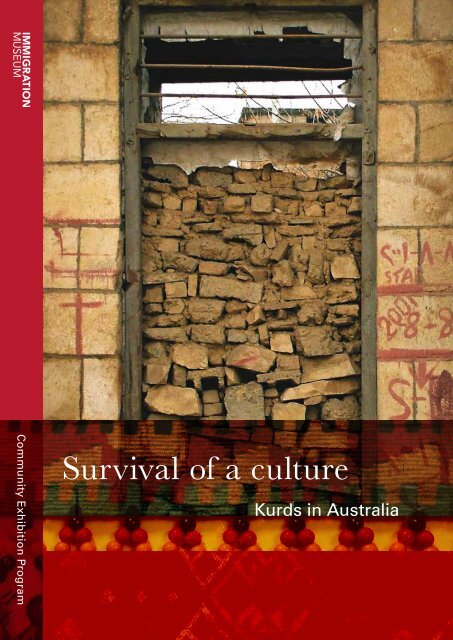
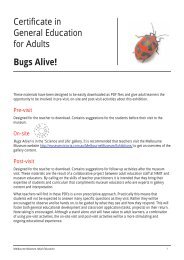

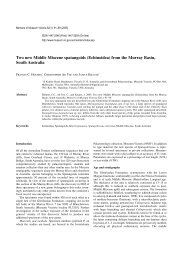
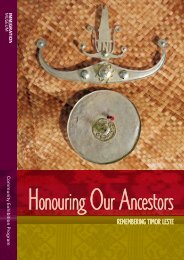
![[PDF] Andiamo a Pompei- Teacher Notes ... la - Museum Victoria](https://img.yumpu.com/16309810/1/190x245/pdf-andiamo-a-pompei-teacher-notes-la-museum-victoria.jpg?quality=85)
